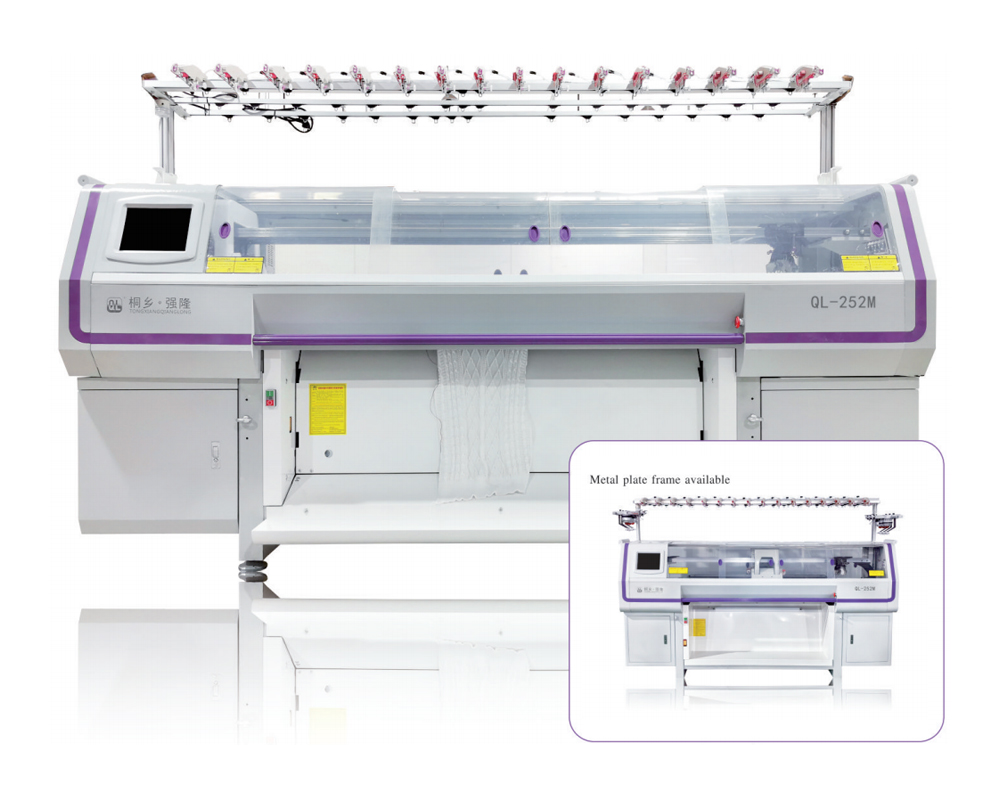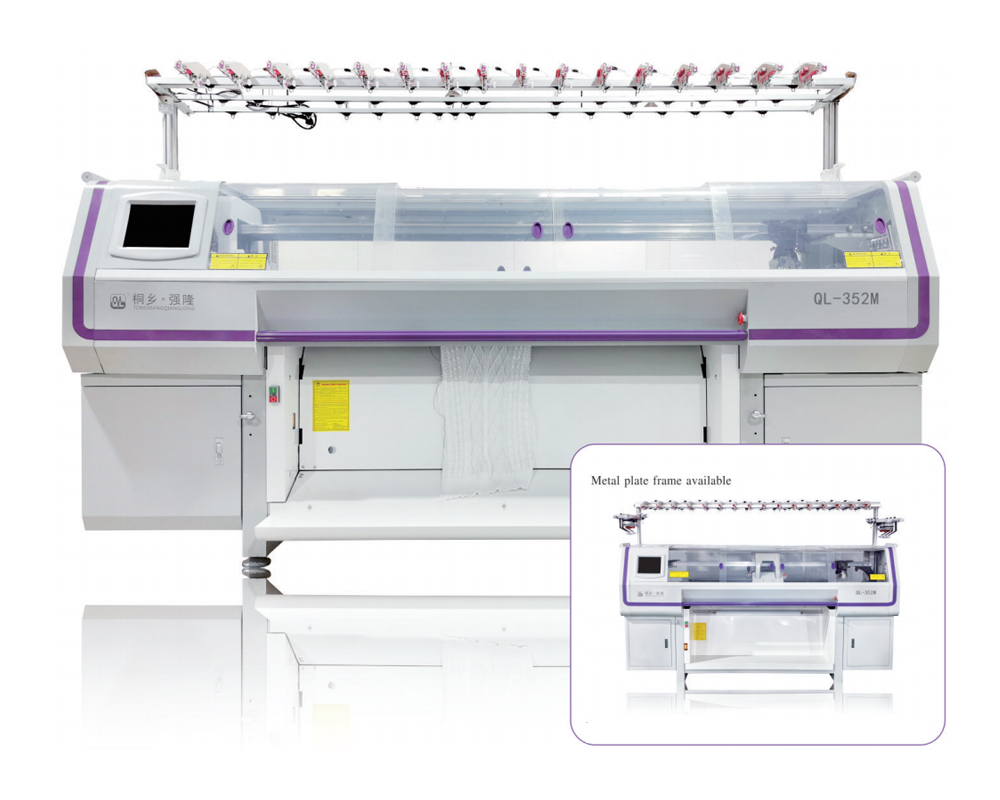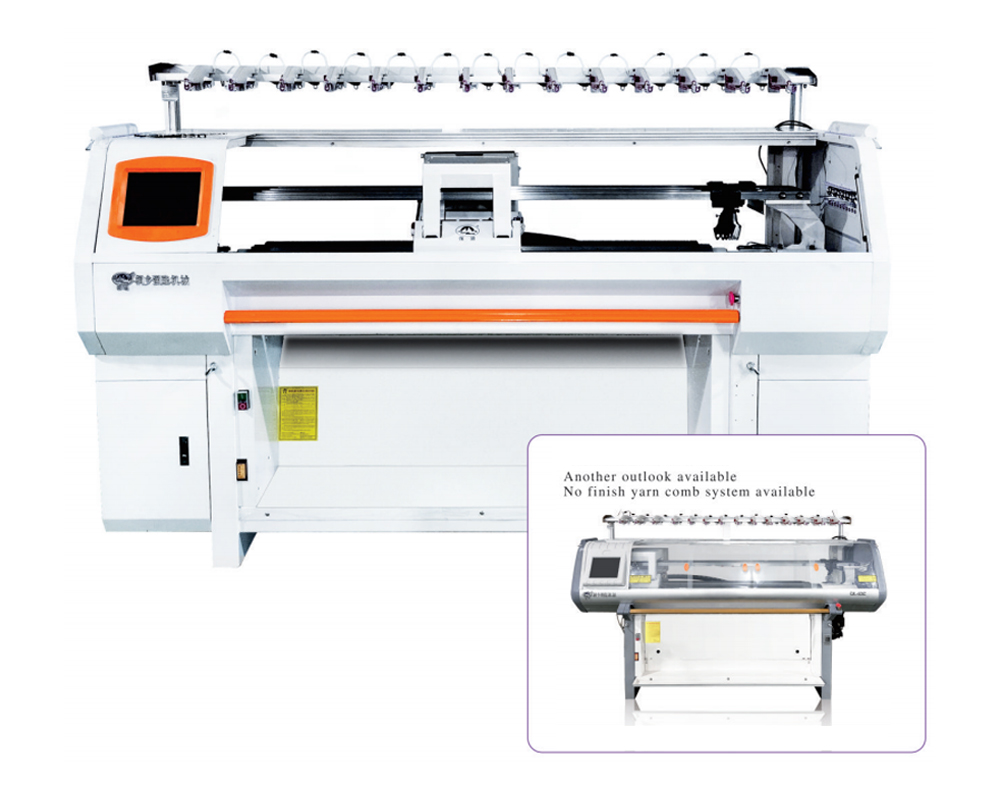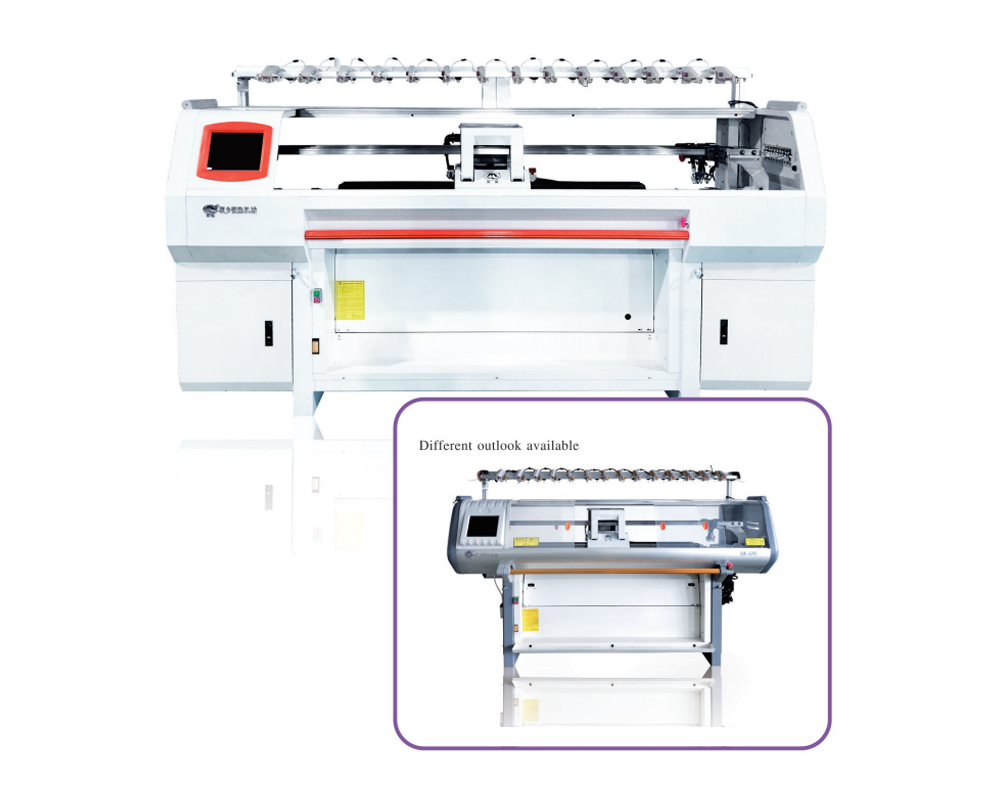Tongxiang Qianglong Machinery Co., Ltd. is high-tech China wholesale computerized flat knitting machine manufacturers, specialized in designing, developing, and manufacturing Knitting Machinery..
Introduction to Computerized Knitting Machines
Knitting, an age-old craft, has seen remarkable transformations over centuries, evolving from simple needles and yarn to complex automated systems. At the forefront of this evolution stands the computerized knitting machine. These innovative devices represent a significant leap forward, blending traditional knitting techniques with modern technology to offer unparalleled precision, speed, and creative freedom.
What is a Computerized Knitting Machine?
A computerized knitting machine is an advanced piece of equipment that automates the process of creating knitted fabrics. Unlike manual or punch-card knitting machines, these devices are controlled by an electronic system, often integrated with a computer or dedicated software. This digital control allows for intricate pattern selection, precise stitch manipulation, and the ability to knit complex designs with incredible efficiency and accuracy that would be impossible or exceedingly time-consuming to achieve by hand. They essentially bring the power of digital design to the world of textile creation.
Brief History and Evolution
The history of machine knitting dates back to 1589 with William Lee's invention of the stocking frame. For centuries, knitting machines were purely mechanical, relying on manual operation and physical mechanisms like punch cards for patterning. The true revolution, however, began in the late 20th century with the advent of electronics and microprocessors. Companies like Shima Seiki were pioneers in developing computerized flat knitting machines in the late 1970s, integrating computer hardware and design systems. This pivotal shift allowed for the storage of vast amounts of knitting data and programs, ushering in an era of electronic knitting machine capabilities that transformed both industrial production and home crafting. The evolution continues with ever more sophisticated software and connectivity options.
Benefits of Using a Computerized Knitting Machine
The advantages of adopting a computerized knitting machine are numerous and compelling for both hobbyists and small businesses:
Increased Efficiency and Speed: These machines can knit significantly faster than manual methods, drastically cutting down production time for garments and projects.
Precision and Consistency: Digital control ensures uniform stitch quality and precise pattern execution, leading to professional-looking results with fewer defects.
Intricate Pattern Capabilities: The ability to program complex designs, including multi-color jacquards, lace, and cable patterns, is a major draw.
Reduced Labor: Many steps that would be tedious and time-consuming in hand knitting are automated, freeing up the knitter for design and finishing.
Versatility: Most computerized machines can handle a wide range of yarns and create various stitch types, offering immense creative flexibility.
Learning and Experimentation: While there's a learning curve, the ability to experiment with digital patterns fosters creativity and allows knitters to push their boundaries.

How Computerized Knitting Machines Work
Understanding the inner workings of a computerized knitting machine reveals the ingenious blend of mechanics and digital control that makes automated knitting possible.
Key Components and Their Functions
At the heart of every computerized knitting machine are several critical components that work in harmony:
Needle Bed: This is the core structure where knitting takes place, consisting of a bed of precisely spaced needles (often latch needles) that move back and forth to form stitches. Machines can have one (single bed) or two (double bed) needle beds.
Carriage: The carriage is the moving part that slides along the needle bed. It contains cams and mechanisms that interact with the needles to form loops, carry the yarn, and determine the stitch type.
Needles: These are the elements that physically create the loops. In computerized machines, individual needles can be selected electronically to knit, tuck, or slip stitches, forming patterns.
Yarn Feeder: This mechanism guides the yarn from the cone or skein to the needles at a consistent tension, ensuring even stitch formation.
Tension Unit: Maintains optimal yarn tension as it feeds into the machine, crucial for uniform stitch size and fabric quality.
Electronic Control Unit/Computer Interface: This is the "brain" of the machine. It receives instructions from the pattern design software and translates them into precise movements for the needles and carriage.
The Role of Software and Pattern Design
The true power of a computerized knitting machine lies in its integration with knitting machine software. This software allows users to design, modify, and store patterns digitally. Key functions of this software include:
Pattern Creation and Editing: Users can draw or import designs, define colors, and specify stitch types (knit, purl, tuck, slip, etc.) for each individual stitch or row.
Simulations: Many advanced software programs offer realistic fabric simulations, allowing designers to visualize the knitted outcome before committing to knitting.
Stitch Manipulation: The software controls which needles are selected at any given moment, enabling the creation of complex textures, cables, lace, and intarsia patterns.
Garment Shaping: Beyond flat patterns, sophisticated software can generate knitting programs for shaped garments, including increases, decreases, and short rows, automating parts of garment construction.
Connectivity: The software typically connects to the machine via a cable or wireless connection, transferring the digital pattern instructions directly to the electronic control unit.
Step-by-Step Knitting Process
While specific operations vary by machine and pattern, the general step-by-step knitting process on a computerized knitting machine follows these stages:
Preparation: The knitter selects the appropriate yarn and machine settings (e.g., tension, gauge).
Pattern Loading: The desired pattern is loaded into the machine's memory via the integrated computer or external software.
Casting On: The initial stitches are cast onto the needles, either manually or with a specific machine function.
Yarn Feeding: The yarn is threaded through the tension unit and into the yarn feeder on the carriage.
Knitting Execution: As the carriage is moved (either manually by pushing, or automatically by a motor in industrial models) across the needle bed, the electronic control unit instructs specific needles to engage. The needles form new loops, pulling the yarn through the previous loops, creating rows of fabric.
Pattern Realization: The computerized control ensures that the needles knit, tuck, or slip stitches according to the loaded pattern, bringing intricate designs to life row by row.
Fabric Take-Up: As the fabric grows, it is pulled down (often by weights or a take-up roller) to maintain proper tension and prevent tangling.
Casting Off: Once the project is complete, the stitches are cast off to secure the edge.
Here's the next section of your article, covering "Types of Computerized Knitting Machines" and "Features to Look for in a Computerized Knitting Machine."
Types of Computerized Knitting Machines
Computerized knitting machines come in various configurations, each designed for specific purposes and types of fabric production. Understanding these distinctions is crucial when selecting the right machine for your projects, whether for a hobby or a burgeoning business.
Flatbed vs. Circular Knitting Machines
The most fundamental distinction in knitting machines lies in their bed shape:
Flatbed Knitting Machines: As the name suggests, these machines have a flat needle bed where the needles are arranged in a straight line. They produce flat panels of knitted fabric, which can then be sewn together to form garments or other items. Flatbed machines are highly versatile and excel at creating intricate patterns, complex shaping (like full fashioning), and different stitch structures. They are commonly used for sweaters, scarves, blankets, and sophisticated apparel. Both home-use and industrial models of computerized flatbed machines are available.
Circular Knitting Machines: These machines feature a cylindrical needle bed, producing fabric in a continuous tubular form. They are primarily used for items like socks, t-shirts, seamless garments, and continuous fabric rolls. While generally faster for mass production of simple tubes, circular machines offer less flexibility for complex patterning and shaping compared to flatbed machines. Most computerized circular knitting machines are found in industrial settings for high-volume manufacturing.
Single Bed vs. Double Bed Machines
Another key differentiation relates to the number of needle beds:
Single Bed Machines: These machines have one flat needle bed and are primarily designed to knit stockinette stitch (knit on one side, purl on the other) and other patterns that don't require opposing purl stitches on the same row, such as fair isle, tuck stitch, and slip stitch. To create true ribbing or garter stitch on a single bed, manual manipulation (like using a garter bar) or a specialized accessory (like a garter carriage) is often required. They are simpler and often more affordable for beginners.
Double Bed Machines (with Ribber): A double bed machine consists of two needle beds set at an angle to each other, forming a "V" shape. This configuration allows the machine to automatically knit true ribbing (like 1x1 or 2x2 rib), double-sided fabrics, and complex patterns like double jacquard without manual stitch manipulation. The second bed, often called a "ribber," greatly expands the range of stitch patterns and fabric types you can produce, including seamless tubes on some models. Many single-bed machines offer a ribber as an optional add-on, transforming them into double-bed capable units.
Industrial vs. Home-Use Models
The scale and complexity of computerized knitting machines vary significantly between industrial and home-use applications:
Industrial Knitting Machines: These are large, robust, and highly automated machines designed for continuous, high-volume production in textile factories. They are often equipped with multiple knitting heads, advanced programming capabilities for complex garment design (including whole garment knitting where an entire garment is knitted seamlessly), automatic yarn feeders, and sophisticated monitoring systems. Industrial machines come with a substantial price tag and require specialized training and dedicated space. They prioritize speed, efficiency, and consistent quality for mass manufacturing.
Home-Use Models: While still offering impressive automation, home-use knitting machines are smaller, more compact, and designed for hobbyists, crafters, and small-scale entrepreneurs. They are generally less expensive and easier to operate, though they still have a learning curve. Many modern home machines feature electronic patterning capabilities, allowing users to create custom designs with included software or popular third-party programs. They are excellent for DIY knitting projects, creating unique garments, and exploring knitwear design without the industrial investment.
Features to Look for in a Computerized Knitting Machine
When considering a computerized knitting machine, several key features will influence its capabilities, ease of use, and suitability for your projects.
Gauge and Needle Count
Gauge is arguably one of the most critical specifications, referring to the number of needles per inch (or 2.54 cm) on the machine's needle bed. It directly determines the thickness of yarn the machine can knit and the density of the resulting fabric:
Fine Gauge (e.g., 3.6mm or 7-12 needles per inch): For very thin, lace-weight, and fingering yarns, producing delicate, lightweight fabrics.
Standard Gauge (e.g., 4.5mm or 5-7 needles per inch): The most common gauge, suitable for fingering to sport weight yarns. This is often considered the "workhorse" for a wide range of garments.
Mid-Gauge (e.g., 6.5mm or 3.5-4.5 needles per inch): Ideal for DK (double knitting) and lighter worsted weight yarns, offering a balance between speed and yarn versatility.
Bulky/Chunky Gauge (e.g., 9mm or 2.5-3.5 needles per inch): Designed for thicker worsted and bulky yarns, creating cozy, heavy fabrics.
The needle count refers to the total number of needles on the bed. A higher needle count allows for knitting wider fabric panels without seams, which is desirable for larger garments like sweaters or blankets.
Stitch Types and Pattern Capabilities
The versatility of a computerized knitting machine is largely defined by its ability to create various stitch types and its pattern capabilities:
Basic Stitches: All computerized machines can produce plain knit (stockinette).
Automated Patterning: Look for machines that can automatically create patterns like:
Fair Isle/Jacquard: Multi-color stranded knitting.
Tuck Stitch: Creates textured effects by holding loops on needles.
Slip Stitch: Creates elongated stitches or textured patterns.
Punch Lace/Thread Lace: Creates openwork patterns by transferring stitches or using fine thread.
Weaving/Plating: Incorporating additional yarns for texture or color.
Ribbing: A double bed or ribber attachment is necessary for true, elastic ribbing.
Cable and Lace: Advanced pattern capabilities often involve stitch transfers, which some machines can automate to varying degrees.
Full Fashioning: The ability to automatically shape garments by increasing or decreasing stitches directly on the machine, minimizing sewing.
Yarn Compatibility
Not all yarns are suitable for every machine. Yarn compatibility depends heavily on the machine's gauge and the fiber type.
Yarn Weight: As discussed with gauge, the machine's needle spacing dictates the appropriate yarn thickness. Using yarn that is too thick for the gauge can lead to dropped stitches, broken needles, and machine damage.
Fiber Type: While most machines can handle various fibers like wool, acrylic, cotton, and blends, some may perform better with certain types. Smooth, evenly spun yarns are generally easier to work with than highly textured or novelty yarns. Coned yarns, designed for machine knitting, tend to feed more smoothly than hand-knitting skeins.
Lubrication: Some yarns, particularly wools, may require a light wax coating or lubrication to glide smoothly through the machine and prevent static or friction issues.
Software and Connectivity
The digital brain of a computerized machine relies on its software and connectivity:
Built-in Software vs. External Programs: Some machines have integrated screens and limited pattern memory, while others rely entirely on external computer software (like DesignaKnit) for pattern creation and transfer. External software generally offers much greater design flexibility and pattern storage.
Pattern Design Capabilities: Evaluate the software's ease of use for creating and modifying patterns. Does it allow for multi-color designs, shaping, and different stitch techniques? Can it import images to convert into knit patterns?
Connectivity (USB, Wi-Fi): How does the machine connect to your computer? USB cables are common for home machines, while more advanced models might offer Wi-Fi for seamless pattern transfer. Reliable connectivity is crucial for smooth operation.
Operating System Compatibility: Ensure the machine's software is compatible with your computer's operating system (Windows, Mac, etc.).
Firmware Updates: The ability to update the machine's firmware ensures it remains compatible with new software features and bug fixes.
Here's the next part of your article, covering "Top Computerized Knitting Machine Brands and Models," "Getting Started with Your Computerized Knitting Machine," and "Advanced Techniques and Tips."
Top Computerized Knitting Machine Brands and Models
The market for computerized knitting machines is primarily dominated by a few key players known for their quality and innovation. While industrial brands like Shima Seiki and Stoll lead in large-scale manufacturing, Brother and Silver Reed (also known as Studio/Knitmaster) are historically the most recognized names for home-use electronic machines.
Brother Knitting Machines
Although Brother stopped manufacturing new home knitting machines in 2000, their machines remain highly sought after in the used market and are still widely used by hobbyists and designers. Brother machines are known for their robust build quality and extensive range of electronic models.
Popular Models: The Brother KH-930, KH-940, KH-950i, KH-965i, and KH-970 are among their most popular electronic models. These standard-gauge machines offered advanced patterning capabilities, often compatible with external software like DesignaKnit for expanded design options.
Features: Many Brother electronic machines featured built-in pattern libraries, interactive knitting capabilities, and the ability to connect to a computer for direct pattern download. They also offered a comprehensive range of accessories, including ribbers (e.g., KR-850), color changers (KRC-900), and lace carriages.
Silver Reed Knitting Machines
Silver Reed (also sold under names like Studio and Knitmaster) is another prominent manufacturer of home knitting machines, and unlike Brother, they continue to produce new models. They offer both mechanical punch-card machines and sophisticated electronic models.
Popular Models: The Silver Reed SK840 is their flagship electronic standard-gauge machine, highly regarded for its connectivity with DesignaKnit software, offering virtually unlimited pattern possibilities. The Silver Reed SK155 is their popular electronic bulky-gauge machine.
Features: Silver Reed machines are known for their smooth operation and compatibility with the powerful DesignaKnit software, which significantly enhances their design capabilities. They also offer a full range of accessories, including ribbers (e.g., SRP60N), lace carriages (LC2), and intarsia carriages (AG24).
Other Notable Brands
While Brother and Silver Reed dominate the home computerized market, other brands are significant, particularly in the industrial sector or for specific types of knitting:
Shima Seiki (Industrial): A global leader in computerized flat knitting machines, especially known for their WHOLEGARMENT® technology, which produces entire garments seamlessly.
Stoll (Industrial): Another major German manufacturer of high-quality computerized flat knitting machines for industrial production, focusing on advanced technology and design solutions.
Passap/Pfaff (Vintage Electronic): While no longer in production, Passap machines (like the E6000) were known for their unique double-bed system and integrated electronic patterning, and they still have a dedicated following.
Addi Express/Sentro (Basic Circular): While not "computerized" in the same complex patterning sense, these popular manual circular knitting machines are often digitally marketed. They offer automated knitting for simple tubes (like hats and scarves) and are excellent for beginners seeking basic machine automation without intricate electronic patterning.
Getting Started with Your Computerized Knitting Machine
Embarking on your computerized knitting journey requires a bit of setup and a grasp of the basics. Don't be intimidated; with patience, you'll soon be creating amazing projects.
Setting Up Your Machine
Proper setup is crucial for smooth operation and quality knitting:
Stable Surface: Place your machine on a sturdy, level table. Many knitting machines have clamps to secure them to the tabletop.
Assembly: Follow your machine's manual for assembly. This typically involves attaching the main bed, tension mast, and yarn guides. If you have a ribber, attach it securely to the main bed.
Sponge Bar Check: The sponge bar (also called the needle retainer bar) is vital for proper needle action. Ensure it's in good condition; a deteriorated sponge bar is a common cause of knitting problems. Replace it if the foam is compressed or crumbly.
Lubrication: Before knitting, lightly oil the needle bed and carriage mechanisms with machine oil designed for knitting machines. Avoid WD-40 or general-purpose oils, as they can cause residue buildup.
Yarn Setup: Thread your chosen yarn through the tension mast and into the yarn feeder on the carriage. Ensure the yarn runs smoothly without snags.
Computer Connection (if applicable): If your machine uses external software, connect the machine to your computer via the appropriate cable (e.g., USB link) and install any necessary drivers.
Basic Operations and Controls
Familiarize yourself with your machine's primary controls:
Carriage Levers: These levers control various functions like knit, tuck, slip, pattern selection, and needle selection. Consult your manual for specific settings for different stitch types.
Tension Dial: Located on the carriage, this dial adjusts the stitch length (and thus the fabric density). Start with a medium setting and swatch to find the ideal tension for your yarn.
Row Counter: An essential feature that tracks the number of rows knitted. Reset it for each new project or section.
Needle Positions: Understand the different positions for your needles (e.g., non-working, working, holding) and how to select them manually or via the carriage.
Yarn Tension Unit: The mast and tension discs regulate the yarn's flow to the needles. Proper tension here is critical for even stitches.
Loading and Knitting Your First Pattern
Your first pattern should be simple to build confidence:
Cast On: Learn a basic cast-on method for your machine (e.g., open cast-on with waste yarn, e-wrap cast-on).
Plain Knitting (Stockinette): Begin by knitting plain rows of stockinette. This allows you to get a feel for the carriage movement and yarn tension.
Pattern Selection: For a computerized machine, select a simple built-in pattern or create a basic repeat in your knitting machine software. Ensure the pattern is transferred successfully to the machine's memory.
Yarn Insertion: Load your working yarn into the main yarn feeder.
Knitting the Pattern: Engage the pattern selector on your carriage. As you push the carriage across the needle bed, watch the needles being selected electronically according to your pattern. Go slowly at first to observe the stitch formation.
Troubleshooting: Don't be discouraged by dropped stitches or missed needles initially. Refer to the "Troubleshooting Common Issues" section and your manual for guidance. Practice is key!
Advanced Techniques and Tips
Once you've mastered the basics, computerized knitting machines offer a vast array of advanced techniques to elevate your projects.
Creating Custom Patterns
The true power of computerized knitting machines shines in their ability to facilitate creating custom patterns:
Design Software: Invest time in learning dedicated knitting machine software like DesignaKnit. These programs provide a graphical interface to design stitch patterns, import images, and even create garment shapes.
Stitch Designer: Use the software's stitch designer to draw individual stitch Repeats. You can specify knit, tuck, slip, or transfer stitches for each pixel, translating directly into machine instructions.
Garment Styling: Many programs include garment styling modules that allow you to input measurements and automatically generate shaping instructions for sweaters, cardigans, and other apparel.
Colorwork: Experiment with intricate multi-color designs like Fair Isle or intarsia. The software helps manage yarn changes and ensures accurate patterning.
Lace and Cables: Advanced features in software can automate complex lace and cable transfers, saving hours of manual manipulation.
Digital to Machine: Once designed, the pattern is transferred from your computer to the machine's memory, ready for knitting.
Troubleshooting Common Issues
Even experienced knitters encounter problems. Knowing how to troubleshoot common issues will save you frustration:
Dropped Stitches: Often caused by a worn sponge bar, incorrect yarn tension, bent or sticky needles, or yarn snagging. Check these first.
Uneven Stitches: Usually a tension issue (yarn tension unit, carriage tension dial, or inconsistent pull of the fabric). Also check for smooth yarn flow.
Carriage Sticking/Hard to Push: Lack of lubrication is a primary culprit. Also check for bent needles, yarn caught under the carriage, or debris in the needle bed.
Pattern Not Engaging: Ensure the pattern selector is engaged, the machine is connected to the computer (if applicable), and the pattern is loaded correctly. Check for dirty optical readers on older electronic models.
Yarn Breaking: Too much tension, knots in the yarn, or a rough spot on the machine can cause breaks.
Ribber Issues: If using a ribber, ensure it's correctly aligned and clamped. Uneven ribbing often points to tension imbalances between the main bed and ribber.
Maintenance and Care
Regular maintenance and care are vital for the longevity and smooth operation of your computerized knitting machine:
Daily Cleaning: After each knitting session, use a soft brush and lint roller to remove all yarn fibers and dust from the needle bed and carriage.
Regular Oiling: Apply a thin layer of specialized knitting machine oil to the needle bed (where the needles slide) and other moving parts of the carriage every few weeks or after extensive use.
Sponge Bar Replacement: Replace your sponge bar periodically (every 1-2 years, depending on use) to ensure consistent needle action. This is the most frequently neglected maintenance item.
Needle Inspection: Regularly inspect needles for bends, rust, or broken latches. Replace damaged needles immediately, as they can cause dropped stitches and affect knitting quality.
Cover When Not in Use: Always cover your machine with a dust cover when not in use to prevent dust and debris buildup.
Professional Servicing: Consider professional servicing every few years, especially for older or heavily used machines, to ensure all internal mechanisms are clean and properly adjusted.
Projects You Can Create with a Computerized Knitting Machine
One of the most exciting aspects of owning a computerized knitting machine is the sheer variety of DIY knitting projects you can tackle. The speed and precision of these machines open up a world of creative possibilities, far beyond what's typically feasible with hand knitting alone.
Garments (Sweaters, Scarves, Hats)
Computerized knitting machines excel at producing a wide range of garments, making them invaluable for both personal wardrobes and small business ventures.
Sweaters and Cardigans: From simple stockinette pullovers to intricate Fair Isle or cabled cardigans, computerized machines can knit panels quickly and accurately. With shaping capabilities, you can create perfectly fitted garments.
Scarves and Shawls: Produce beautifully draped scarves in various stitch patterns, from delicate lace to cozy chunky knits, in a fraction of the time.
Hats and Beanies: Whether flat-knitted and seamed or tubularly knitted on a double bed, hats with custom designs, stripes, or textures are easily achievable.
Socks and Gloves: With the right machine (especially circular or fine-gauge flatbeds with specific techniques), you can create perfectly fitting socks and gloves, complete with shaping for heels and fingers.
Home Decor (Blankets, Cushions)
Beyond apparel, automated knitting is perfect for creating bespoke home decor items that add a personal touch to any space.
Blankets and Throws: Knit large, comfortable blankets or throws much faster than by hand. Experiment with different colors, textures, and even complex pictorial designs.
Cushion Covers: Create unique cushion covers with intricate patterns, custom monograms, or textural elements to match your interior design.
Table Runners and Placemats: Add elegance to your dining area with custom-knitted table linens in durable and washable yarns.
Accessories (Socks, Gloves)
Small knitting machine projects are ideal for honing your skills and creating quick gifts or stock for a craft market.
Socks: As mentioned, with specialized techniques or circular machines, machine-knitted socks can be a satisfying and practical project.
Mittens and Gloves: Customize gloves and mittens with various stitch patterns and shaping.
Bags and Pouches: Knit sturdy fabric for tote bags, clutches, or small pouches, then assemble them with linings and hardware.
The Future of Computerized Knitting
The world of computerized knitting machines is continuously evolving, driven by advancements in software, hardware, and the increasing demand for customization and sustainable production.
Emerging Technologies
Several emerging technologies are shaping the future of digital knitting:
3D Knitting and WholeGarment® Technology: Industrial machines from leaders like Shima Seiki are pushing the boundaries of 3D knitting, where entire garments, complete with shaping, are knitted seamlessly in one piece, eliminating the need for cutting and sewing. This reduces waste and production time.
Advanced Robotics and Automation: Further automation of yarn feeding, tension control, and even post-knitting processes will continue to increase efficiency in industrial settings.
Integration with CAD/CAM Software: Seamless integration with sophisticated Computer-Aided Design and Manufacturing software allows for more complex and precise garment design and production workflows.
Smart Textiles: Research into knitting conductive yarns and integrating sensors directly into knitted fabrics is opening doors for smart garments and e-textiles.
AI and Machine Learning: Artificial intelligence could potentially be used for optimizing knitting patterns, predicting yarn behavior, and even generating novel designs based on user input.
The Impact on the Knitting Industry
The impact of computerized knitting machines on the knitting industry is profound:
On-Demand Manufacturing: The agility of these machines allows for smaller batch production and on-demand manufacturing, reducing waste and inventory. This supports more sustainable and ethical production models.
Customization and Personalization: Digital control enables unprecedented levels of customization, allowing brands to offer personalized garments tailored to individual customer preferences.
Reduced Labor Costs: While machines require skilled operators, they significantly reduce the manual labor involved in knitting, especially for complex designs.
Reshoring Production: The efficiency and precision of modern machines are making it more economically viable to bring textile production back to countries with higher labor costs.
Opportunities for Designers and Creators
For designers and creators, computerized knitting machines unlock immense opportunities:
Rapid Prototyping: Designers can quickly knit samples and prototypes of their designs, speeding up the development process.
Creative Freedom: The ability to translate complex digital patterns into physical textiles offers unparalleled creative freedom, allowing for intricate textures, complex colorwork, and innovative garment structures.
Micro-Manufacturing and Niche Markets: Small businesses and individual artisans can produce high-quality, unique knitwear efficiently, catering to niche markets and direct-to-consumer sales.
Sustainable Practices: Designers can experiment with sustainable yarns and utilize whole garment knitting to minimize textile waste, aligning with growing consumer demand for eco-friendly products.
Education and Research: These machines are vital tools in textile design education and research, enabling students and academics to explore new knitting techniques and material science.
Conclusion
The computerized knitting machine stands as a testament to how technology can revolutionize an ancient craft. From its humble beginnings to today's sophisticated electronic marvels, these machines have transformed knitting from a time-consuming manual process into a realm of high-speed, high-precision automated knitting. They empower modern knitters, designers, and manufacturers to create complex, beautiful, and consistent knitted fabrics with unprecedented ease and efficiency.
Whether you're a hobbyist dreaming of perfectly patterned sweaters, an artisan building a small business designing unique knitwear, or simply curious about the intersection of technology and textiles, a computerized knitting machine offers a compelling blend of artistic freedom and practical utility. By understanding the types of knitting machines, their features to look for, and the power of knitting machine software, you can unlock a world of creative potential. Embrace the future of knitting; your next masterpiece might just be a few clicks away.
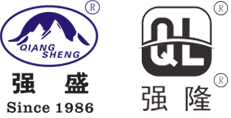
 English
English 简体中文
简体中文
 Chinese
Chinese English
English
